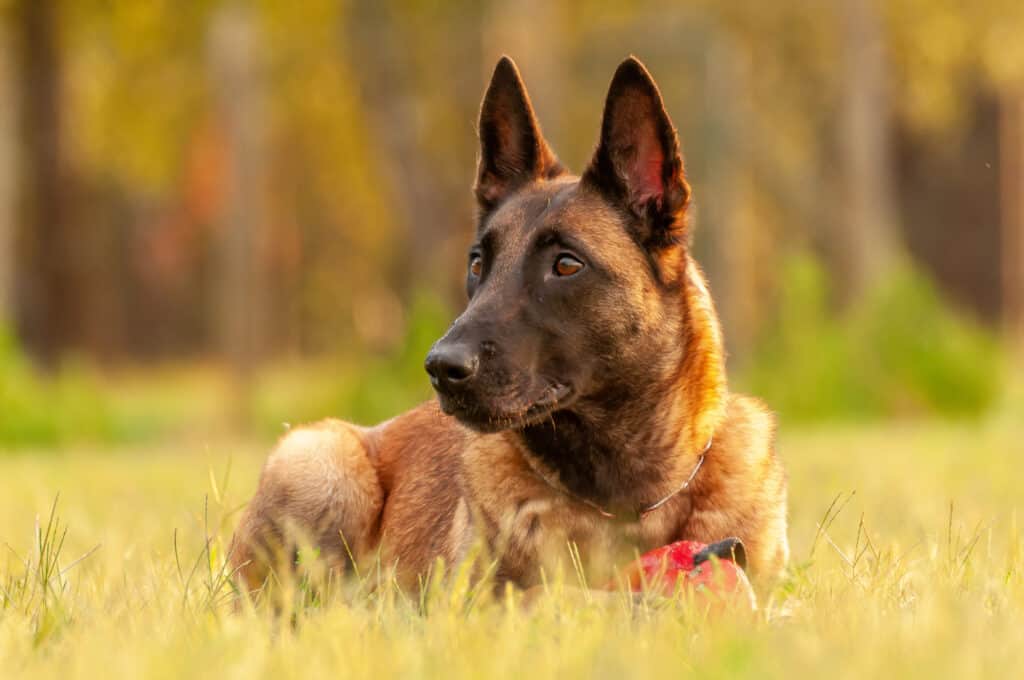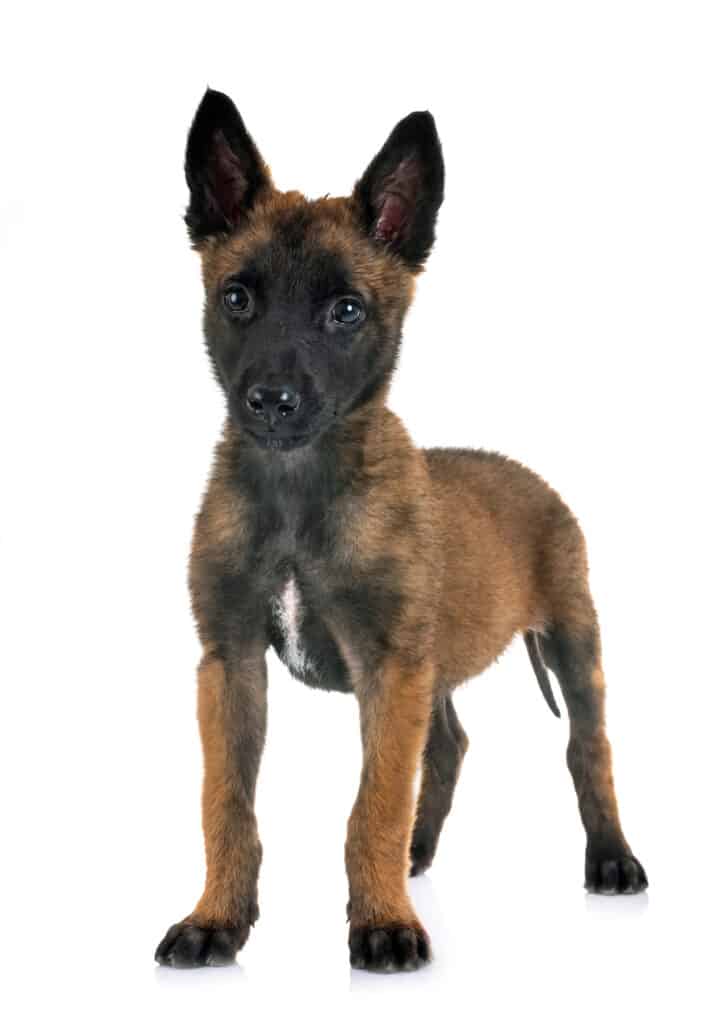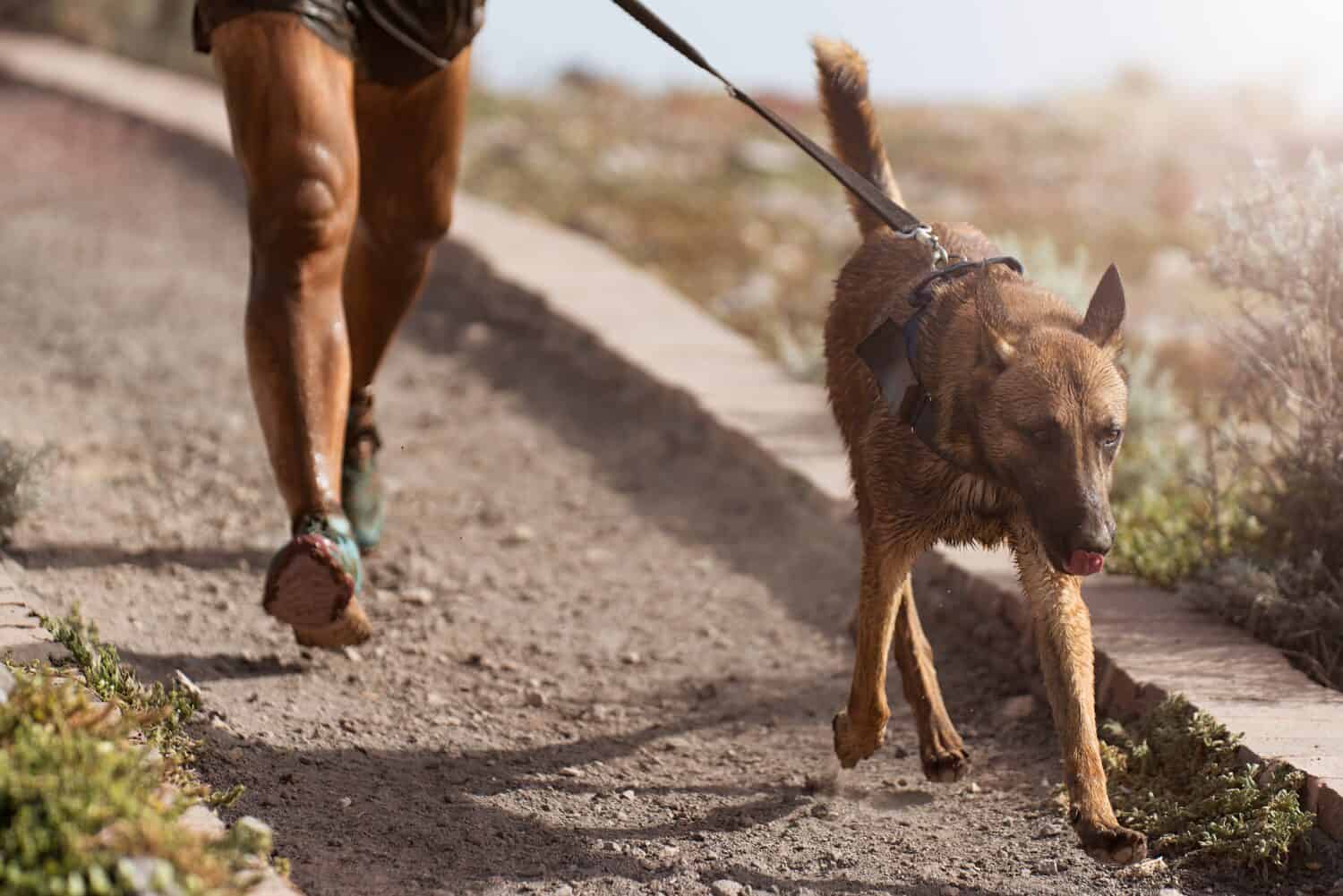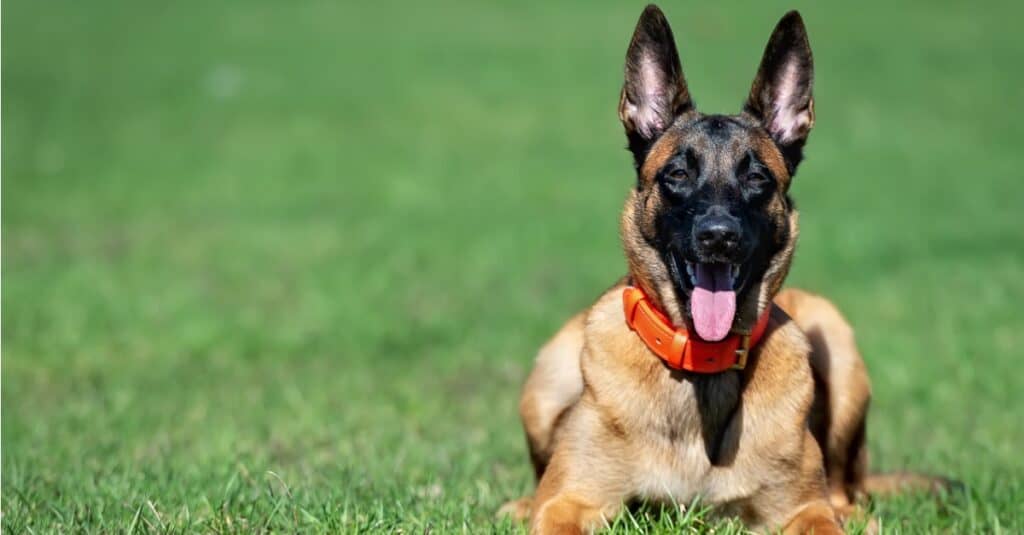Belgian Malinois is a breed of working dog known for its intelligence and versatility. In this article, we will delve into everything you need to know about these remarkable canines. From their incredible herding instincts to their famous movie roles.
About the Belgian Malinois

German Malinois are brave and protective, making them fierce guard dogs.
©Bianca Grueneberg/Shutterstock.com
The Belgian Malinois is a breed of dog that has become increasingly popular due to its intelligence, loyalty, and strength. It is a medium-sized breed that is well-muscled and athletic in appearance. The breed is known for its alertness and short, smooth coat.
Popular coat colors for the Belgian Malinois include fawn, mahogany, and black. Other colors, such as brindle and red, are also seen. The breed has a long, straight muzzle and strong jaws. The ears are triangular, and the eyes are almond-shaped.
The Belgian Malinois is an active, energetic breed that needs regular exercise and mental stimulation. They are well suited for work and excel in dog sports such as agility and obedience. They are also excellent family companions that are loyal and affectionate.
History of the Belgian Malinois
The Belgian Malinois, originally bred around the city of Malines in Belgium, is one of four related breeds of Belgian herding dogs. These breeds, which include the Laekenois, Tervuren, and Belgian Shepherd (Groenendael), are recognized as a single breed in some countries. However, in America, the Malinois has been classified as a separate dog breed since 1959. This breed is similar to the German Shepherd dog but has a different facial shape and is more slender. Used by sheepherders and cattlemen in its native land, this dog is known for its excellent herding skills. It was bred by knowledgeable dog owners who focused on performance rather than trends.
The Belgian Malinois breed was first brought to America in 1911. After World War II, there was a shortage of European breeding stock which caused the breed to decline in the U.S. until the early 1960s when supporters began replenishing its population. Today, Mals are used for herding stock, but due to their versatility and high work drive. They are also popular in police and military roles.
Appearance

The average weight of a Belgian Malinois is between 40-80 pounds. Females are smaller than males.
©Nordantin/Shutterstock.com
The Belgian Malinois is a strong, agile breed with an elegant and proud carriage. They are built to handle the rugged Belgian climate and have a balanced square shape when viewed from the side.
According to breed standards, males should be 24-26 inches tall at the withers, while females should be 22-24 inches tall. Males weigh between 60-80 pounds. Females weigh between 40-60 pounds.
The length of the dog should match its height. It is important that they have a moderate bone structure in proportion to their height so they are neither too slender nor bulky. The look of the dog should reflect its herding heritage, with males appearing masculine and females appearing feminine.
Temperament of Belgian Malinois
The Belgian Malinois is a highly active, intelligent, and confident breed of dog. They are highly motivated and thrive with positive training methods, making them an ideal companion for active owners. They are often used in law enforcement and military work due to their loyalty, protective nature, and trainability.
Compared to other popular breeds, the Belgian Malinois is often considered to be more independent and bold. They are also known to be more energetic and require more physical and mental stimulation than other breeds. This makes them an ideal choice for owners who are looking for an active and loyal companion.
Lifespan and Health

A Belgian malinois puppy looks similar to a German shepherd pup. They live between 10-14 years.
©cynoclub/Shutterstock.com
The Belgian Malinois lifespan is 10-14 years. Compared to many breeds, these dogs don’t have a lot of health concerns. This is especially true if you obtain the dog from a responsible dog breeder. That said, Belgian Malinois has a few common health concerns to watch out for.
The Belgian Malinois breed is prone to elbow and hip dysplasia, inherited structural joint issues that can cause pain and arthritis. Check for lameness with no past trauma, popping sounds from the joints, or abnormal gait when running. Before bringing home a puppy of this breed, make sure the parents have been tested for these conditions. If your pet does develop dysplasia, treatment can be anything from medication and supplements to surgery.
Cataracts in Belgian Malinois are a potential issue caused by the hardening of the eye lens. If this happens, surgery may be necessary to replace the lens and restore sight.
Progressive retinal atrophy (PRA) is another eye condition that affects this breed, causing retina deterioration over time and leading to blindness. Unfortunately, there is no cure for PRA. However, a reputable breeder will screen the parents to make sure it’s not passed on to their puppies. Signs of PRA include difficulty seeing, such as bumping into things, tripping over curbs or stairs, etc.
Grooming
The short coat of the Malinois is waterproof and quite easy to take care of. Occasional brushing with a medium-bristle brush, a grooming mitt, or a glove will keep the dog looking his best. Brushing promotes new hair growth and distributes skin oils throughout the coat as well. Malinois sheds twice a year. During these periods, a daily once-over with a brush will help to remove the loose hair.
As with all breeds, the toenails should be trimmed every two or three weeks. Overly long nails can cause the dog pain as well as problems walking and running. Additionally, regularly checking the ears for wax and debris buildup is important to maintain the health of the ears. Brushing the teeth is also important to prevent plaque and tartar buildup and should be done at least two or three times a week.
Overall, grooming a Malinois is not particularly difficult. Regular brushing and nail trimming, combined with occasional baths, will keep your Malinois looking and feeling his best.
Exercise Needs of Belgian Malinois

If you want a full-time running partner or canicross competitor, the Belgian Malinois is for you.
©Pavel1964/Shutterstock.com
Belgian Malinois are highly intelligent and muscular dogs known for their unwavering loyalty. They thrive when they have an active and engaging lifestyle with their owners, both physically and mentally. Simply leaving them in the backyard or taking them on daily walks is not enough to fulfill their exercise needs. To truly keep a Malinois happy, regular and vigorous exercise is paramount. After all, they are very athletic dogs.
Depriving a Malinois of physical activity and human companionship would be detrimental to their well-being as these dogs are bred to work closely alongside humans. Their purpose in life revolves around being actively involved with their owners. Whether it’s participating in agility competitions or embarking on intense hiking adventures, this breed craves stimulation that challenges both its mind and body.
A Belgian Malinois makes an exceptional running partner due to its high energy levels and endurance. With boundless enthusiasm, they will happily accompany you on long-distance runs without tiring easily. Hiking enthusiasts will find solace in the company of a Malinois as they possess natural agility, making them agile climbers even over rough terrains.
Biking enthusiasts can also rejoice because these dogs excel at keeping up with fast-paced rides thanks to their remarkable speed and stamina. The sense of camaraderie experienced while cycling side by side with your furry companion can be incredibly rewarding for both dog and owner alike.
In addition to outdoor activities, Belgian Malinois exhibits extraordinary skills in various competitive sports, such as obedience trials or tracking.
Diet
A Belgian malinois is an active, intelligent breed of dog that requires a diet that meets its unique nutritional needs. This breed should be given a diet that is high in protein with moderate amounts of fat and carbohydrates. It is important to provide a balanced diet with a variety of healthy foods, including meat, vegetables, and grains. Additionally, omega-3 fatty acids, such as fish or algae oil, can help keep the coat healthy and provide other benefits. It is also important to provide plenty of fresh water throughout the day.
Training

Clicker training and positive reinforcement work wonders with a Belgian Malinois.
©Gajus/Shutterstock.com
In addition to early socialization and obedience training, there are several tips for positive reinforcement dog training that can be beneficial when working with Belgian Malinois or any other breed.
Firstly, consistency is key. Dogs thrive on routine and structure, so it is important to establish clear rules and expectations from the beginning. Consistently rewarding desired behaviors with treats, praise, or playtime will reinforce those behaviors and encourage your Malinois to continue behaving in a desirable manner.
Secondly, it’s important to use high-value rewards during training sessions. While some dogs may be motivated by simple praise or a pat on the head, others may require more enticing incentives, such as small pieces of their favorite treats or access to their favorite toys. By using rewards that your Malinois finds particularly valuable, you’ll increase their motivation to learn and cooperate during training sessions.
Furthermore, breaking down commands into smaller steps can make learning easier for your Malinois. Instead of expecting them to instantly understand complex commands like “sit-stay,” start by teaching them each component separately. First, teaching them how to sit reliably before moving on to the stay command. This incremental approach allows your dog to build confidence through successful repetitions and ensures they fully understand what is expected of them at each stage.
Another effective tip is utilizing positive reinforcement techniques such as clicker training. Clicker training involves using a clicker device (or even just a distinct sound) paired with immediate reward delivery whenever your Malinois performs the desired behavior correctly.
Cost: Understanding the Purchase Price and Ongoing Expenses of a Belgian Malinois
The cost of owning a Belgian Malinois is an important factor to consider before making a purchase. The purchase price of a Belgian Malinois can vary greatly depending on the breeder and the lineage of the dog, with prices ranging anywhere from $800 to $5,000.
In addition to the purchase price, there are ongoing expenses associated with owning a Belgian Malinois. These include food, grooming, vet bills, and training. These costs can add up quickly, so it is important to consider these costs before making a commitment to owning one of these dogs.
Food costs for a Belgian Malinois can range from $30 to $150 per month, depending on the quality of food chosen. Grooming costs will also vary depending on the type of grooming desired and the frequency with which it is done. Vet bills should also be taken into account, as these can also vary greatly depending on the needs of the individual dog.
Finally, training is also an important expense to consider. Professional training and classes can range from $50 to $200 per month. It is important to invest in proper training for Belgian Malinois to ensure that they are able to live a happy and healthy life.
Conclusion

The Belgian Malinois is easy to train and valued as a police and military dog.
©iStock.com/Sansargo
Sharing your life with a Belgian Malinois is an extraordinary experience that requires a great deal of commitment and responsibility. The Belgian Malinois is a highly intelligent and active breed that needs regular mental and physical stimulation. They are loyal and devoted to their owners and form strong bonds with those they trust. With the right training and socialization, they can make wonderful family pets.
The rewards of owning a Belgian Malinois are numerous. Not only are these dogs incredibly loyal and loving, but they are also incredibly smart and capable. They are often used as working dogs, as they have the intelligence and focus to excel in tasks such as search and rescue, guard and protection, and agility. Their intelligence and drive make them great candidates for advanced obedience and agility training as well. With the right amount of exercise and stimulation, these dogs can be well-mannered and loving companions.
The photo featured at the top of this post is © Fesus Robert/Shutterstock.com
Ready to discover the top 10 cutest dog breeds in the entire world?
How about the fastest dogs, the largest dogs and those that are -- quite frankly -- just the kindest dogs on the planet? Each day, AZ Animals sends out lists just like this to our thousands of email subscribers. And the best part? It's FREE. Join today by entering your email below.
Thank you for reading! Have some feedback for us? Contact the AZ Animals editorial team.







